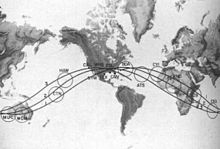Maspalomas Station
INTA (Spain) | |
| Location | San Bartolomé de Tirajana, Province of Las Palmas, Canary Islands, Spain |
|---|---|
| Coordinates | 27°45′48″N 15°38′03″W / 27.7633°N 15.6342°W |
| Website | www.inta.es |
| | |
| ] | |
Maspalomas Station is an
History

From the 1950s the momentum was growing in the
The original Maspalomas Station was built by NASA close to the Maspalomas Lighthouse in 1960. It was initially set to provide support for NASA's first human spaceflight mission, the Mercury Program, one of 14 such stations in the Manned Space Flight Network (MSFN) distributed around the globe. It came into operation on 13 September 1961 to support the Mercury-Atlas 4 test flight, and continued to take part in Mercury missions, including John Glenn’s Mercury-Atlas 6 Earth orbit. Subsequently, Maspalomas participated in the ground control network for NASA's crewed flight programme Project Gemini (1965-1966).[1]
The expansion of tourism in the southern part of Grand Canaria threatened the
Maspalomas Station continued to provide support for international space missions, including the launch of early communications satellites by Intelsat, who named their third satellite, Intelsat II F-3, Canary Bird after the Canary Islands.[2]
Apollo program
Maspalomas Station supported a number of prominent NASA missions, including the
During the Moon landing on 20 July, Maspalomas provided the real-time backup for the MSFN station at the former Fresnedillas Station, Madrid (now the Madrid Deep Space Communications Complex) while the Apollo 11 crew made their first steps onto the Moon.[4]
In October 1969, in recognition of the role played by Maspalomas Station, the Apollo 11 crew visited Gran Canaria as part of their 38-day world tour and stayed at the newly built Oasis Hotel in Maspalomas.[9][7]
Later missions

After the Apollo Missions, Maspalomas supported a number of other important NASA projects, including the monitoring of the
In the late 1970s and early 1980s, ESA began to expand operations in Spain, establishing the
Facilities
Maspalomas Station holds a 15-metre (50 foot)
The station regularly provides support for missions for the European Space Agency (ESA) via the European Space Operations Centre (ESOC) in Darmstadt, Germany, including the Cluster satellite mission, MetOp-2 and the SMART-1 Moon mission.[10]
Maspalomas has also supported other international space projects, among them missions for the
The facility has been commissioned to support China's forthcoming Chang'e 5 mission to retrieve samples of Moon rock (postponed to 2019).[11]
References
Citations
- ^ a b c d Dorado, José M.; Bautista, Manuel; Sanz-Aránguez, Pedro. "Spain in Space: A short history of Spanish activity in the space sector" (PDF). European Space Agency. Retrieved 8 February 2019.
- ^ Dickson 2009, p. 101.
- ^ Gaudio 1995, pp. 70–71.
- ^ a b c d "European Apollo ground station pioneer". European Space Agency. 15 July 2009. Archived from the original on 8 February 2019. Retrieved 8 February 2019.
- ^ "Day 1, part 2: Earth Orbit and Translunar Injection". Apollo 11 Flight Journal. Retrieved 2019-07-10.
- ^ Manned Spacecraft Center. Apollo 11: Spacecraft Commentary (PDF). Houston, Texas: NASA. p. 16.
- ^ a b c Cabañas 2009, p. 83.
- ^ Lopez, Pedro José Franco (20 July 2014). "De la luna a Maspalomas" [From the Moon to Maspalomas]. La Provincia (in Spanish). Retrieved 9 February 2019.
- ^ "Apollo 11 Crew Starts World Tour". Logan Daily News. Logan, Ohio. Associated Press. September 29, 1969. p. 1 – via Newspapers.com.
- ^ a b c "Maspalomas station". European Space Agency. Archived from the original on 8 February 2019. Retrieved 8 February 2019.
- ^ Jones, Andrew (30 May 2017). "ESA to assist China's Chang'e-5 mission to the Moon and back". GB Times. Retrieved 8 February 2019.
Sources
- Cabañas, Nadjejda Vicente (2009). La cuenta atrás. De la carrera espacial al turismo cósmico [The Countdown. From the Space Race to Cosmic Tourism] (in Spanish). Santa Cruz de Tenerife: Gobierno de Canarias D.L. OCLC 733850748.
- Dickson, Paul (2009). A Dictionary of the Space Age. Baltimore: NASA/Johns Hopkins University Press. p. 101 – via EPDF.
- Gaudio, Attilio (1995). Les îles Canaries [The Canary Islands]. KARTHALA Editions. ISBN 9782865375585.



